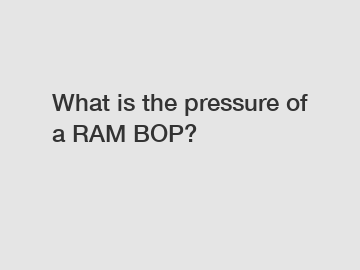What is the pressure of a RAM BOP?
What is the Pressure of a RAM BOP? .
As the oil and gas industry continues to evolve, the demand for advanced drilling technologies and equipment increases. One such piece of vital equipment used in drilling operations is the Blowout Preventer (BOP). Among its various types, the RAM BOP plays a crucial role in well control by sealing off the wellbore in case of a blowout. In this article, we delve into the pressure of a RAM BOP, exploring its significance, functionality, and capabilities.
1. Understanding the Basics of a RAM BOP:

A RAM BOP, short for Ram-Type Blowout Preventer, is designed to seal the wellbore by utilizing two opposing sets of hydraulically or mechanically operated rams. These rams can be classified into two main types: pipe rams and blind rams. Pipe rams are used to seal around the drill pipe or tubing, while blind rams seal off the wellbore in the absence of any tubular components.
2. Pressure Ratings of a RAM BOP:
Pressure is a critical consideration when dealing with any BOP. The pressure rating of a RAM BOP defines the maximum amount of pressure it can effectively withstand. These BOPs are available in a range of pressure ratings, typically from 5,000 to 20,000 pounds per square inch (psi), depending on the specific requirements of the drilling operation. It is essential to match the BOP's pressure rating with the anticipated well pressure to ensure efficient well control.
3. Factors Influencing Pressure Requirements:
The pressure requirements of a RAM BOP can vary depending on several factors. The depth of the well, the reservoir pressure, and the anticipated drilling fluid density are the key parameters that influence the pressure demands. Deepwater drilling operations typically require BOPs with higher pressure ratings due to the higher anticipated pressures at greater depths.
4. RAM BOP Stack Configurations:
The pressure of a RAM BOP is one of the critical considerations when configuring a BOP stack. A BOP stack refers to the arrangement of multiple BOPs on the wellhead assembly. The stack configuration may include various components like annular BOPs, diverter systems, and multiple RAM BOPs. It is crucial to ensure that the pressure ratings of the RAM BOPs used in the stack are capable of withstanding the maximum pressure encountered during drilling operations.
5. Preventing Blowouts and Ensuring Well Control:
The primary purpose of a RAM BOP is to prevent blowouts and maintain control over the wellbore. Blowouts occur when the pressure exerted by the formation exceeds the hydrostatic pressure of the drilling fluid. By rapidly activating the rams, the RAM BOP can effectively seal off the well, preventing uncontrolled release of hydrocarbons. The pressure rating of the RAM BOP plays a crucial role in the effectiveness of well control operations.
6. Compliance with Industry Standards:
To ensure the safety and reliability of drilling operations, RAM BOPs must adhere to strict industry standards and certifications. Organizations like the American Petroleum Institute (API) provide guidelines and specifications for the design, manufacture, and testing of BOPs to meet the rigorous standards set by the industry. Compliance with these standards guarantees that the RAM BOP can withstand the pressures it is rated for.
In conclusion, the pressure of a RAM BOP is a vital consideration in well control operations in the oil and gas industry. A properly rated RAM BOP ensures the safe operation of drilling activities by effectively sealing off the wellbore in case of a blowout. By understanding the basics of a RAM BOP, its pressure requirements, and compliance with industry standards, drilling operators can enhance safety measures and mitigate potential risks during drilling operations.
If you want to learn more, please visit our website oil drilling bop, 18 3/4”ram bop, drilling bop manufacturers.


